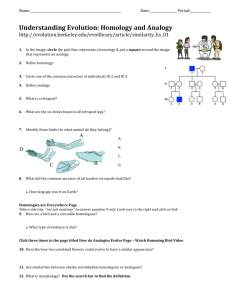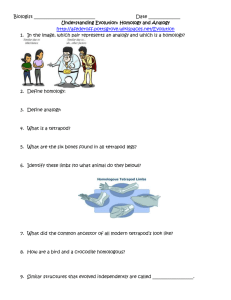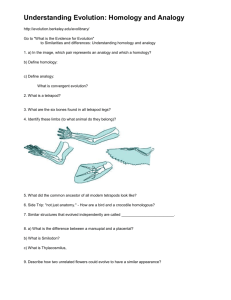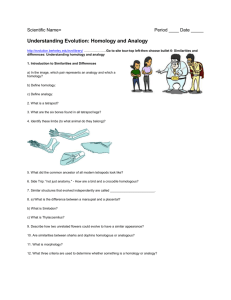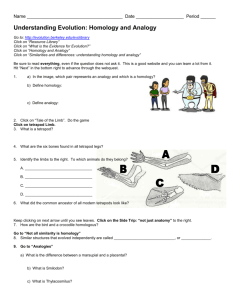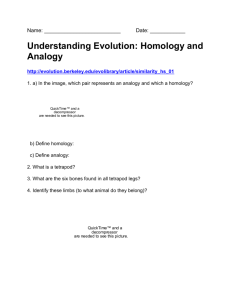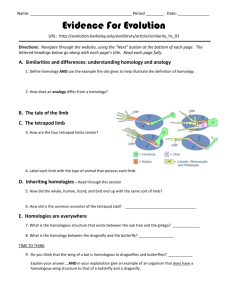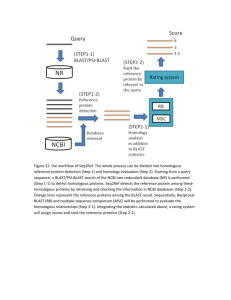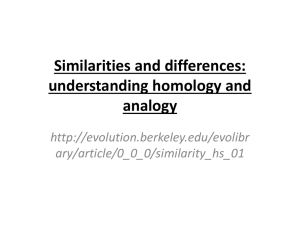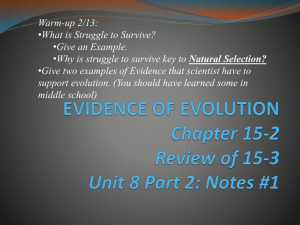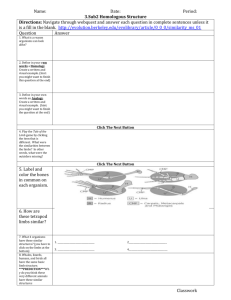Understanding Evolution: Homology and Analogy
advertisement
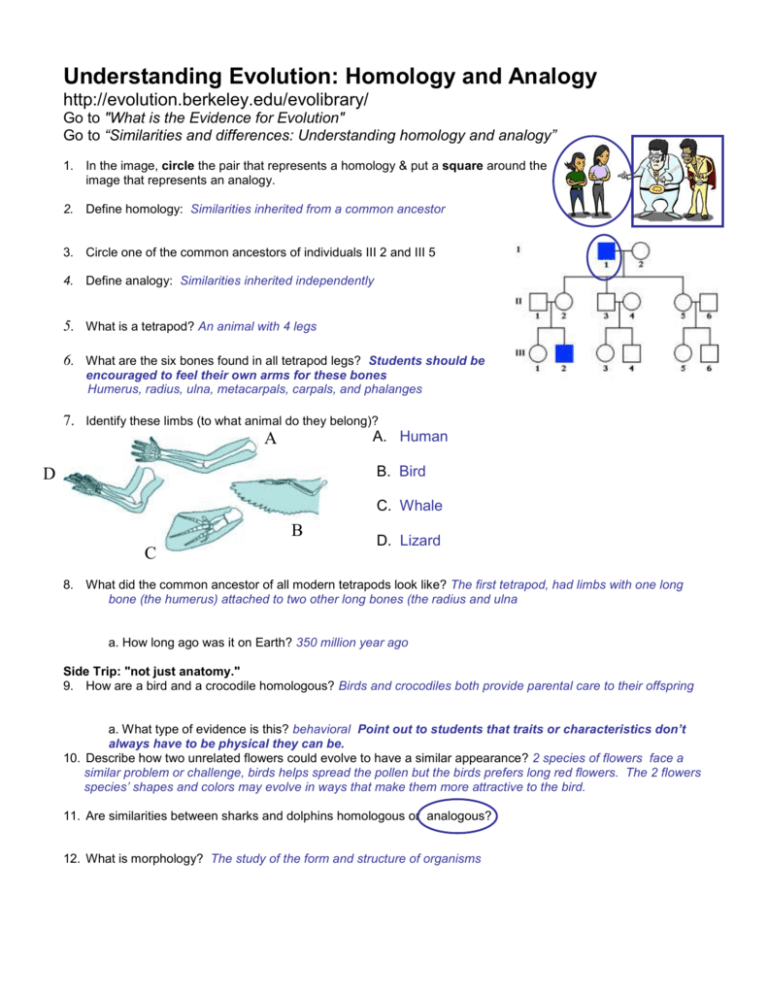
Understanding Evolution: Homology and Analogy http://evolution.berkeley.edu/evolibrary/ Go to "What is the Evidence for Evolution" Go to “Similarities and differences: Understanding homology and analogy” 1. In the image, circle the pair that represents a homology & put a square around the image that represents an analogy. 2. Define homology: Similarities inherited from a common ancestor 3. Circle one of the common ancestors of individuals III 2 and III 5 4. Define analogy: Similarities inherited independently 5. What is a tetrapod? An animal with 4 legs 6. What are the six bones found in all tetrapod legs? Students should be encouraged to feel their own arms for these bones Humerus, radius, ulna, metacarpals, carpals, and phalanges 7. Identify these limbs (to what animal do they belong)? A. Human A B. Bird D C. Whale B C D. Lizard 8. What did the common ancestor of all modern tetrapods look like? The first tetrapod, had limbs with one long bone (the humerus) attached to two other long bones (the radius and ulna a. How long ago was it on Earth? 350 million year ago Side Trip: "not just anatomy." 9. How are a bird and a crocodile homologous? Birds and crocodiles both provide parental care to their offspring a. What type of evidence is this? behavioral Point out to students that traits or characteristics don’t always have to be physical they can be. 10. Describe how two unrelated flowers could evolve to have a similar appearance? 2 species of flowers face a similar problem or challenge, birds helps spread the pollen but the birds prefers long red flowers. The 2 flowers species’ shapes and colors may evolve in ways that make them more attractive to the bird. 11. Are similarities between sharks and dolphins homologous or analogous? 12. What is morphology? The study of the form and structure of organisms 13. List three criteria that are used to determine whether something is a homology or analogy and what kind of evidence it is, a. Same basic structure – anatomy/anatomical b. Same relationship to other features – anatomy/anatomical c. Same development – embryology/embryological 14. Fill in the blanks of the primate tree. Panda Chimpanzee Human Gorilla 15. Considering all of the evidence, are the "wings" (actually flaps of skin stretched between the legs) of sugar gliders and flying squirrels homologous or analogous structures? a. List two pieces of evidence that support your answer. Underline the one that is anatomical evidence. Sugar gliders live in Australia, and flying squirrels live in North America Sugar gliders have a pouch, Flying squirrels have no pouch. 16. What other type of evidence do Biologist look at when trying to determine relationships between different species. Genetic/biolchemistry Side Trip: See more examples of homology and examples of analogy. 17. How are a Venus fly trap and a pitcher plant homologous? Use leaves to trap insects a. What type of evidence is this? behavioral 18. Biologists link the various species of the bowerbird to a common ancestor with what kind of evidence? Behavioral 19. Give an example of genetic evidence that links insects, humans and birds to a common ancestor. The pax-6 gene that codes for eyes is the same in all 20. The evidence linking lizards and modern mammals to a common ancestor is genetic, behavioral or embryological? 21. What mechanism independently adapted Sugar gliders and flying squirrels for similar lifestyles: leaping from treetops (hence, the gliding "wings") and foraging at night (hence, the big eyes). Natural Selection 22. List 4 types of evidence that were discussed in this webquest. Anatomical, behavioral, embryologyl/biochemical, genetic/biochemistry a. Use the highlighter to highlight one example of each in the questions/answers above. Understanding Evolution: Homology and Analogy http://evolution.berkeley.edu/evolibrary/ Go to "What is the Evidence for Evolution" Go to “Similarities and differences: Understanding homology and analogy” 1. In the image, circle the pair that represents a homology & put a square around the image that represents an analogy. 2. Define homology: 3. Circle one of the common ancestors of individuals III 2 and III 5 4. Define analogy: 5. What is a tetrapod? 6. What are the six bones found in all tetrapod legs? 7. Identify these limbs (to what animal do they belong)? A. A B. D C. B C D. 8. What did the common ancestor of all modern tetrapods look like? a. How long ago was it on Earth? Side Trip: "not just anatomy." 9. How are a bird and a crocodile homologous? a. What type of evidence is this? 10. Describe how two unrelated flowers could evolve to have a similar appearance? 11. Are similarities between sharks and dolphins homologous or analogous? 12. What is morphology? 13. List three criteria that are used to determine whether something is a homology or analogy and what kind of evidence it is, a. b. c. 14. Fill in the blanks of the primate tree. 15. Considering all of the evidence, are the "wings" (actually flaps of skin stretched between the legs) of sugar gliders and flying squirrels homologous or analogous structures? a. List two pieces of evidence that support your answer. Underline the one that is anatomical evidence. 16. What other type of evidence do Biologist look at when trying to determine relationships between different species. Side Trip: See more examples of homology and examples of analogy. 17. How are a Venus fly trap and a pitcher plant homologous? a. What type of evidence is this? 18. Biologists link the various species of the bowerbird to a common ancestor with what kind of evidence? 19. Give an example of genetic evidence that links insects, humans and birds to a common ancestor. 20. The evidence linking lizards and modern mammals to a common ancestor is genetic, behavioral or embryological? 21. What mechanism independently adapted Sugar gliders and flying squirrels for similar lifestyles: leaping from treetops (hence, the gliding "wings") and foraging at night (hence, the big eyes). 22. List four types of evidence that were discussed in this webquest. a. Use the highlighter to highlight one example of each in the questions/answers above.
